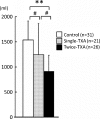Repeat-dose intravenous tranexamic acid further decreases blood loss in total knee arthroplasty
- PMID: 23371424
- PMCID: PMC3580084
- DOI: 10.1007/s00264-013-1787-7
Repeat-dose intravenous tranexamic acid further decreases blood loss in total knee arthroplasty
Abstract
Purpose: Tranexamic acid (TXA) reduces blood loss in patients undergoing total knee arthroplasty (TKA). However, few studies have reported the optimum timing and dosage for administration of TXA. The purpose of this study was to evaluate the effect of repeat-dose TXA on blood loss during TKA and the necessity of autologous blood donation or postoperative autotransfusion.
Methods: We enrolled 78 patients with primary osteoarthritis undergoing cemented TKAs. Consecutive patients were divided into three groups, as follows: control group (n = 31), single-TXA group (n = 21) in whom TXA (1,000 mg) was intravenously administered 10 min before deflation of the tourniquet, and twice-TXA group (n = 26) in whom TXA (1,000 mg) was intravenously administered 10 min before deflation of the tourniquet and 3 h after the operation. We measured the volume of drained blood after the operation. Haemoglobin (Hb) levels were measured at days 1, 4 and 7 postoperation. Venous thromboembolic events (VTE) were screened using compression ultrasonography at enrollment and 1 and 7 days after operation.
Results: The mean volume of drained blood after the operation was lower in the twice-TXA group than in the single-TXA (p < 0.001) and control (p < 0.0001) groups. No significant differences were observed in the incidence of VTE between these groups.
Conclusion: Administration of TXA twice reduced postoperative blood loss after TKA, and TXA was not associated with the risk of deep-vein thrombosis (DVT) or pulmonary embolism (PE). Further, administration of TXA twice may eliminate the need for blood transfusion during TKA.
Figures



Comment in
-
Inadequate methodology renders results on the use of tranexamic acid inconclusive.Int Orthop. 2013 Jul;37(7):1417-8. doi: 10.1007/s00264-013-1889-2. Epub 2013 Apr 25. Int Orthop. 2013. PMID: 23615922 Free PMC article. No abstract available.
-
Reply to Letter to the Editor: Inadequate methodology renders results on the use of tranexamic acid inconclusive.Int Orthop. 2013 Aug;37(8):1647. doi: 10.1007/s00264-013-1910-9. Epub 2013 Jun 13. Int Orthop. 2013. PMID: 23760680 Free PMC article. No abstract available.
Similar articles
-
Intravenous versus topical tranexamic acid administration in primary total knee arthroplasty: a meta-analysis.Knee Surg Sports Traumatol Arthrosc. 2017 Nov;25(11):3585-3595. doi: 10.1007/s00167-016-4235-6. Epub 2016 Jul 14. Knee Surg Sports Traumatol Arthrosc. 2017. PMID: 27417102
-
[A PROSPECTIVE RANDOMIZED SELF-CONTROLLED STUDY ON EFFECT OF TRANEXAMIC ACID IN REDUCING BLOOD LOSS IN TOTAL KNEE ARTHROPLASTY].Zhongguo Xiu Fu Chong Jian Wai Ke Za Zhi. 2015 Mar;29(3):280-3. Zhongguo Xiu Fu Chong Jian Wai Ke Za Zhi. 2015. PMID: 26455190 Clinical Trial. Chinese.
-
Multiple Boluses of Intravenous Tranexamic Acid to Reduce Hidden Blood Loss After Primary Total Knee Arthroplasty Without Tourniquet: A Randomized Clinical Trial.J Arthroplasty. 2016 Nov;31(11):2458-2464. doi: 10.1016/j.arth.2016.04.034. Epub 2016 May 6. J Arthroplasty. 2016. PMID: 27262419 Clinical Trial.
-
The efficacy and safety of combined administration of intravenous and topical tranexamic acid in primary total knee arthroplasty: a meta-analysis of randomized controlled trials.BMC Musculoskelet Disord. 2018 Sep 7;19(1):321. doi: 10.1186/s12891-018-2181-9. BMC Musculoskelet Disord. 2018. PMID: 30193586 Free PMC article. Review.
-
Intra-articular versus intravenous tranexamic acid application in total knee arthroplasty: a meta-analysis of randomized controlled trials.Arch Orthop Trauma Surg. 2017 Jul;137(7):997-1009. doi: 10.1007/s00402-017-2683-1. Epub 2017 Apr 4. Arch Orthop Trauma Surg. 2017. PMID: 28378211 Review.
Cited by
-
Tranexamic acid: current use in obstetrics, major orthopedic, and trauma surgery.Can J Anaesth. 2021 Jun;68(6):894-917. doi: 10.1007/s12630-021-01967-7. Epub 2021 May 15. Can J Anaesth. 2021. PMID: 33993459 Review. English.
-
Effectiveness of an autologous transfusion system following cemented and non-cemented revisions of total hip arthroplasty.Int Orthop. 2014 Aug;38(8):1603-8. doi: 10.1007/s00264-014-2359-1. Epub 2014 May 11. Int Orthop. 2014. PMID: 24817099 Free PMC article.
-
Are Three Doses of Intravenous Tranexamic Acid more Effective than Single Dose in Reducing Blood Loss During Bilateral Total Knee Arthroplasty?Indian J Orthop. 2020 Aug 14;54(6):805-810. doi: 10.1007/s43465-020-00231-2. eCollection 2020 Nov. Indian J Orthop. 2020. PMID: 33133403 Free PMC article.
-
Can local infiltration analgesia supplemented with tranexamic acid reduce blood loss during total knee arthroplasty?BMC Musculoskelet Disord. 2024 Apr 26;25(1):333. doi: 10.1186/s12891-024-07451-9. BMC Musculoskelet Disord. 2024. PMID: 38671411 Free PMC article.
-
The efficacy and safety of multiple-dose intravenous tranexamic acid on blood loss following total knee arthroplasty: a randomized controlled trial.Int Orthop. 2017 Oct;41(10):2053-2059. doi: 10.1007/s00264-017-3519-x. Epub 2017 May 31. Int Orthop. 2017. PMID: 28567578 Clinical Trial.
References
-
- Sehat KR, Evans RL, Newman JH. Hidden blood loss following hip and knee arthroplasty. Correct management of blood loss should take hidden loss into account. J Bone Joint Surg Br. 2004;86–4:561–565. - PubMed
-
- Adalberth G, Bystrom S, Kolstad K, Mallmin H, Milbrink J. Postoperative drainage of knee arthroplasty is not necessary: a randomized study of 90 patients. Acta Orthop Scand. 1998;69–5:475–478. - PubMed
MeSH terms
Substances
LinkOut - more resources
Full Text Sources
Other Literature Sources
Medical

